Amazing Birds at Wheeler National Wildlife Refuge
 Saturday, January 16, 2016 at 9:00PM
Saturday, January 16, 2016 at 9:00PM The view was jaw-dropping, as good as it gets for bird-lovers, or for those who just appreciate an amazing sight when they see it. This morning I was at Wheeler National Wildlife Refuge, near Decatur, Alabama, at the peak of winter migration of the Sandhill Cranes, who began their journey in Wisconsin and southern Canada.
This morning I was at Wheeler National Wildlife Refuge, near Decatur, Alabama, at the peak of winter migration of the Sandhill Cranes, who began their journey in Wisconsin and southern Canada.
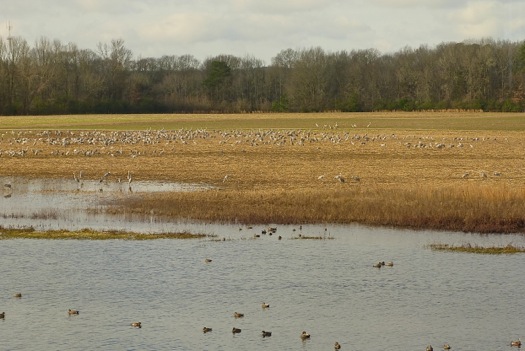
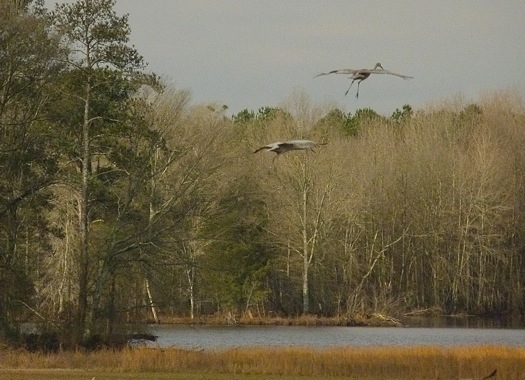
 There were literally thousands of Sandhill Cranes, along with even more thousands of different types of ducks.
There were literally thousands of Sandhill Cranes, along with even more thousands of different types of ducks.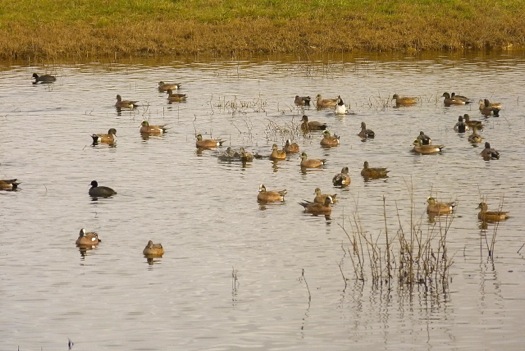
And four Whooping Cranes. In the following photo, you can see the four Whooping Cranes. They are white, and their legs are banded. The rest of the cranes are the Sandhills, which are gray:
 The Whooping Crane is an endangered species, whose numbers at one time dropped to a perilous twenty-one. Careful management has increased their numbers to about 440 in the wild and 160 in captivity, still a very rare bird. There are actually five Whooping Cranes at the refuge, but number five was in another part of the refuge, which covers 35,000 acres.
The Whooping Crane is an endangered species, whose numbers at one time dropped to a perilous twenty-one. Careful management has increased their numbers to about 440 in the wild and 160 in captivity, still a very rare bird. There are actually five Whooping Cranes at the refuge, but number five was in another part of the refuge, which covers 35,000 acres.
The refuge offers diverse habitat types that provide excellent feeding, resting, and roosting sites for wintering cranes and waterfowl, as well as nesting sites for migratory songbirds and many species of resident wildlife. In a share agreement, local farmers cultivate several thousand acres of cropland inside the refuge, and a portion of the crops is left in the field as a food source for wildlife.
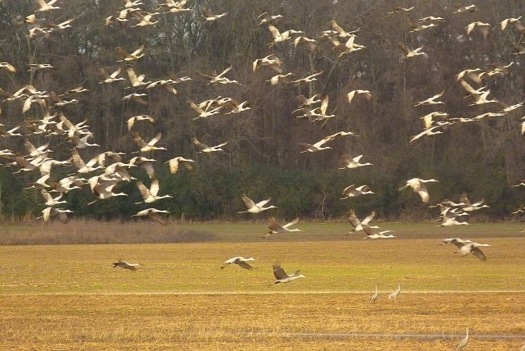
 A trio of flying Sandhill Cranes.
A trio of flying Sandhill Cranes.


 White Pelicans fly over in formation.
White Pelicans fly over in formation.
Most of these photos were taken from within the comfort of an enclosed observatory, but there are a number of trails inside the refuge to accommodate birders and other wildlife lovers.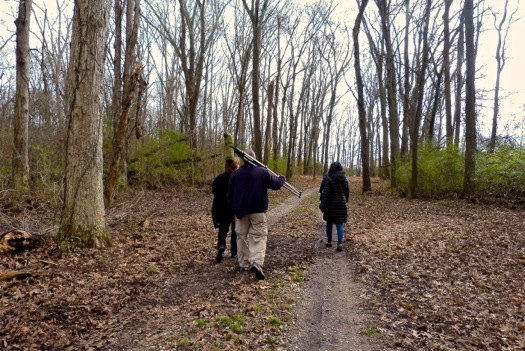
I woke up at 5:00 a.m. on a Saturday morning to drive up to see all this. It was worth it!
Reader Comments (19)
Hi Deb, the sight of so many migrating Sandhill Cranes is indeed stunning! I think, I hadn't even seen one of these cranes before. Thank you so much for sharing! Even though I am not especially into birds I was captivated by your photos and I am glad that this special refuge exists for them to make their life a little easier!
Warm regards,
Christina
Some things are truly worth getting up for and this is one of them. Such amazing photos - I particularly like the one of a trio of cranes. Wonderful!
Wow! That is an impressive sight. One early morning as I was hiking through the sand dunes in Michigan I scared up a few sandhill cranes. They are such impressive birds. I would totally get up at 5 am to be able to see this. Thanks for sharing your experience!
that must have been such an exciting experience!
Wow, you got some amazing shots. It's neat to think that many of the Whooping Cranes and Sandhill Cranes spend their summers near me and their winters near you. :) Thanks for sharing highlights from your visit to the wildlife refuge.
I really enjoyed your spectacular photo series; we are so fortunate to have such amazing assets like this refuges.
What an exciting morning! It must have been breathtaking to see so many birds. It would be fun to be able to follow them on GPS while they travel. Thanks for sharing these pictures. Beautiful!
What an incredible experience, Deb! I couldn't help but to think of my late mother-in-law who was an avid birder for much of her life - I would have loved to share your photos with her as they're spectacular. Thanks for sharing your visit!
What an amazing sight, well worth getting up early for. You must have had a wonderful time there seeing so many huge birds all at once. It sounds very like our Wildfowl and Wetland Trust where we can see thousands of migrating geese and swans, they are such a lifeline for the birds.
Amazing, I'm going to send the link to my husband who is very keen; perhaps he'll want to visit! Christina
You have to know that I appreciated you getting up at 5am. I just love to see all those cranes. Being a birder, that is an amazing sight for anyone. We wait until spring to see that many birds. Great pictures, Deb.
Fantastic shots of those cranes, they look massive!!
Awesome!
What time do you need to get to the refuge for the best birding? :)
Must have been an arresting sight to see all those birds! Great shots!
Hello everyone, and thank you for your comments! Aaron, you asked about the best time to see the birds. The cranes usually stay through February; their numbers diminish after that. Time of day is not so crucial - you are bound to see them any time, but morning and late afternoon is when they are most active. The observatory is open seven days a week through the winter. Saturday at 10:00 a.m. there is an interesting presentation in the observatory about the cranes. Deb
Where is Wheeler? Is it close at all to Mobile? What a magnificent array of birds! How did you get that picture with the silhouette of the crane's head?
Hi Jason, the refuge is several hundred miles from Mobile, which is in the southwestern part of Alabama on the Gulf coast. Wheeler is in the northern part of Alabama, adjacent to the Tennessee River.
Regarding the silhouette of the cranes head - I was wondering if someone would ask about that! I totally cheated. That was a cardboard crane in the window of the observatory! Best wishes, Deb
What an amazing place. Definitely worth getting up for! It reminds me of Lake Mattamuskeet in NC, which is the winter home of thousands of tundra swan, snow geese, Canada geese and other waterfowl including pintails, blue-winged tails, hooded mergansers, etc. You have reminded me that I must check to see how far it is from us. We went once, when we lived in Chapel Hill, and spent 10 hours in the car on a one day trip. We saw so many swans, geese and ducks on that day.
I'm glad you got up so early, great to see these Cranes and your great shots.